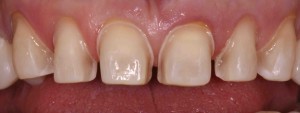 One of the common requests dentists get from patients seeking restorative dentistry is to “close” the black triangles giving their teeth an unattractive appearance.
One of the common requests dentists get from patients seeking restorative dentistry is to “close” the black triangles giving their teeth an unattractive appearance.
By Dr. Lee Ann Brady
On the one hand, fixing black triangles can be an enjoyable way to give the patient an easy to see, drastic change in the attractiveness of their smile. On the other hand, it poses many challenges that can potentially create distress rather than excitement for the patient.
Using the Dental Lab to Your Advantage – Closing Black Triangles
There are many factors to keep in mind when considering how to best close black triangles in the esthetic zone:
- The height of the papilla.
- How this compares to the adjacent teeth.
- Is there papilla symmetry?
- What is the relative position of the papilla tip to the proposed incisal edge position?
The fourth factor can end in two different scenarios. You have an easy restoration ahead of you if the length of tooth is split between papilla and the contact. All that follows is solid preparation design and a veneer that can change the tooth shape.
But, if there is a short papilla relative to the final tooth length, you will need to speak to your patient about achievable expectations. Though they don’t know the ins and outs of dentistry and have a different sense of a successful restoration, you could end up with a long contact when you close the embrasure space and unhappy patient.
It’s a result that a patient might prefer to black triangles, but that will not be satisfying to most dentists and even to some patients.
Going the veneer route can become a challenge during the attempt to avoid creating a ledge interproximally. This is where you can use the dental lab to your advantage. While preparing the tooth, make sure that you are giving the ceramist plenty of room to create a new emergence profile.
The new emergence profile will not only close the gingival embrasure form, but it will ensure a smooth contour that can assist with maintaining periodontal health.
Clinical Goal: A preparation that continues through the contact and ends at the mesial and distal line angles of the tooth.
The gingival margin of the preparation should mimic the scallop and be higher interproximally then it is on the facial. This is another way that you can assist the lab technician. Take the preparation margin as far subgingivally in the interproximal as possible without violating the biologic attachment.



Well written Lee Ann! Concise